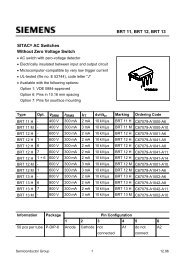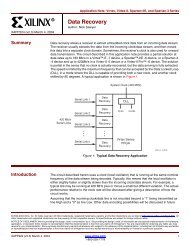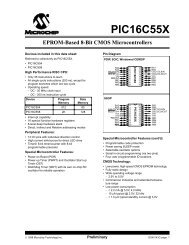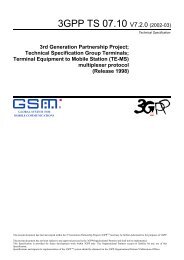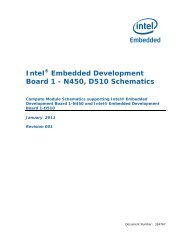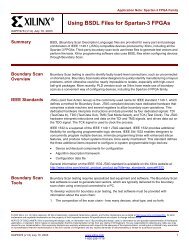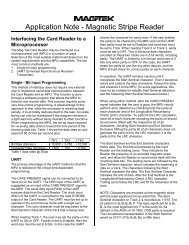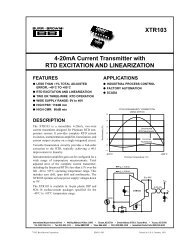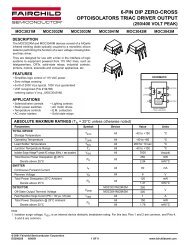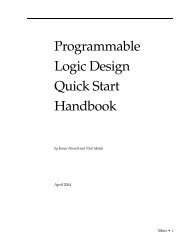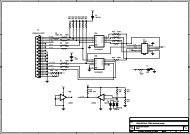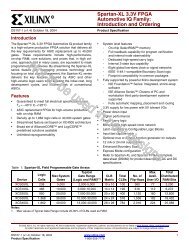Small Block vs. Large Block NAND Devices
Small Block vs. Large Block NAND Devices
Small Block vs. Large Block NAND Devices
Create successful ePaper yourself
Turn your PDF publications into a flip-book with our unique Google optimized e-Paper software.
Technical Note<br />
<strong>Small</strong> <strong>Block</strong> <strong>vs</strong>. <strong>Large</strong> <strong>Block</strong> <strong>NAND</strong> Flash <strong>Devices</strong><br />
TN-29-07: <strong>Small</strong> <strong>Block</strong> <strong>vs</strong>. <strong>Large</strong> <strong>Block</strong> <strong>NAND</strong> Flash <strong>Devices</strong><br />
Introduction<br />
Introduction<br />
As <strong>NAND</strong> Flash devices have increased to densities of 1Gb and beyond, it has become<br />
necessary to organize the <strong>NAND</strong> Flash array more efficiently, and simultaneously reduce<br />
costs.<br />
Increasing the block size of the <strong>NAND</strong> Flash array accomplishes both of these goals.<br />
Using fewer blocks increases READ, PROGRAM, and ERASE performance, and reduces<br />
chip size by reducing peripheral circuits between blocks. Most newer <strong>NAND</strong> Flash<br />
designs use the large block format.<br />
A general rule for determining when <strong>NAND</strong> Flash devices transition from small block to<br />
large block organization is:<br />
• <strong>Small</strong> block devices ≤ 1Gb density.<br />
• <strong>Large</strong> block devices ≥ 1Gb density.<br />
Micron offers a family of Flash memory products with several large block <strong>NAND</strong> Flash<br />
devices, including but not limited to:<br />
MT29F2G08AAB—2Gb, 3.3V, x8 interface<br />
MT29F2G16AAB—2Gb, 3.3V, x16 interface<br />
MT29F1G08ABA—1Gb, 1.8V, x8 interface<br />
MT29F1G16ABA—1Gb, 1.8V, x16 interface<br />
09005aef81999ecb pdf/ 09005aef81999f9d source<br />
Micron Technology, Inc., reserves the right to change products or specifications without notice.<br />
tn2907_sm_block_<strong>vs</strong>_lg_block.fm - Rev. B 2/06 EN 1 ©2005 Micron Technology, Inc. All rights reserved.<br />
Products and specifications discussed herein are for evaluation and reference purposes only and are subject to change by<br />
Micron without notice. Products are only warranted by Micron to meet Micron’s production data sheet specifications. All<br />
information discussed herein is provided on an “as is” basis, without warranties of any kind.
Array Organization<br />
TN-29-07: <strong>Small</strong> <strong>Block</strong> <strong>vs</strong>. <strong>Large</strong> <strong>Block</strong> <strong>NAND</strong> Flash <strong>Devices</strong><br />
Array Organization<br />
<strong>Small</strong> block <strong>NAND</strong> Flash devices contain blocks made up of 32 pages, where each page<br />
contains 512 data bytes + 16 spare bytes. <strong>Large</strong> block <strong>NAND</strong> Flash devices contain blocks<br />
made up of 64 pages, each page containing 2,048 data bytes + 64 spare bytes. For a 1Gb<br />
<strong>NAND</strong> Flash device, this translates to 8,192 blocks in the small block organization, and<br />
1,024 blocks in the large block organization.<br />
These organizational differences are highlighted in Figures 1 and 2, and Table 1 on<br />
page 3.<br />
Figure 1:<br />
1Gb <strong>NAND</strong> Flash <strong>Small</strong> <strong>Block</strong> Array Organization<br />
528 bytes<br />
Data Register: 512 bytes 16<br />
I/O 7<br />
I/O 0<br />
256K pages<br />
(8,192 blocks)<br />
per device<br />
1st Half of<br />
Data Register<br />
(256 bytes)<br />
1 <strong>Block</strong><br />
2nd Half of<br />
Data Register<br />
(256 bytes)<br />
1 page = 528 bytes<br />
1 block = 528 bytes x 32 pages<br />
= (16K + 512) bytes<br />
1 device = 528 bytes x 32 pages x 8,192 blocks<br />
= 1,056 Mb<br />
8 bits<br />
512 bytes (data)<br />
16-byte<br />
spare area<br />
Figure 2:<br />
1Gb <strong>NAND</strong> Flash <strong>Large</strong> <strong>Block</strong> Array Organization<br />
2,112 bytes<br />
Data Register 2,048 bytes<br />
64<br />
I/O 7<br />
I/O 0<br />
1 page = (2K + 64 bytes)<br />
1,024 blocks<br />
per device<br />
1 <strong>Block</strong><br />
1 block = (2K + 64) bytes x 64 pages<br />
= (128K + 4K) bytes<br />
1 device = (2K + 64) bytes x 64 pages x 1,024 blocks<br />
= 1,056 Mb<br />
2,048 bytes (data)<br />
64-byte<br />
spare area<br />
09005aef81999ecb pdf/ 09005aef81999f9d source<br />
Micron Technology, Inc., reserves the right to change products or specifications without notice.<br />
tn2907_sm_block_<strong>vs</strong>_lg_block.fm - Rev. B 2/06 EN 2 ©2005 Micron Technology, Inc. All rights reserved.
TN-29-07: <strong>Small</strong> <strong>Block</strong> <strong>vs</strong>. <strong>Large</strong> <strong>Block</strong> <strong>NAND</strong> Flash <strong>Devices</strong><br />
Address Cycles<br />
Table 1:<br />
<strong>Small</strong> <strong>Block</strong>/<strong>Large</strong> <strong>Block</strong> Comparison<br />
Page # <strong>Small</strong> <strong>Block</strong> <strong>Large</strong> <strong>Block</strong><br />
0 512 bytes + 16 bytes 2,048 bytes + 64 bytes<br />
1 512 bytes + 16 bytes 2,048 bytes + 64 bytes<br />
2 512 bytes + 16 bytes 2,048 bytes + 64 bytes<br />
… … …<br />
30 512 bytes + 16 bytes 2,048 bytes + 64 bytes<br />
31 512 bytes + 16 bytes 2,048 bytes + 64 bytes<br />
32 n/a 2,048 bytes + 64 bytes<br />
… … …<br />
62 n/a 2,048 bytes + 64 bytes<br />
63 n/a 2,048 bytes + 64 bytes<br />
Total bytes 16,896 135,168<br />
Address Cycles<br />
<strong>NAND</strong> Flash devices have no dedicated address pins. Addresses are loaded via a shared<br />
I/O bus that is also used for loading commands and data. <strong>Small</strong> block and large block<br />
<strong>NAND</strong> Flash devices use four address cycles to load the entire address for a 1Gb device.<br />
However, as shown in Tables 2 and 3, the address cycles are used differently by small<br />
block and large block devices. The small block devices use one column address cycle<br />
while the large block devices require two column address cycles. <strong>Small</strong> block devices<br />
require more row address cycles due to the increased number of blocks.<br />
<strong>Large</strong> block 2Gb devices use five address cycles.<br />
Table 2:<br />
<strong>Small</strong> <strong>Block</strong> <strong>NAND</strong> Flash Address Cycles<br />
Cycle I/O7 I/O6 I/O5 I/O4 I/O3 I/O2 I/O1 I/O0<br />
1 A7 A6 A5 A4 A3 A2 A1 A0<br />
2 A16 A15 A14 A13 A12 A11 A10 A9 1<br />
3 A24 A23 A22 A21 A20 A19 A18 A17<br />
4 LOW LOW LOW LOW LOW LOW A26 A25<br />
Notes:<br />
1. There is no A8 address bit in small block devices.<br />
Table 3:<br />
<strong>Large</strong> <strong>Block</strong> <strong>NAND</strong> Flash Address Cycles<br />
Cycle I/O7 I/O6 I/O5 I/O4 I/O3 I/O2 I/O1 I/O0<br />
1 CA7 CA6 CA5 CA4 CA3 CA2 CA1 CA0<br />
2 LOW LOW LOW LOW CA11 CA10 CA9 CA8<br />
3 RA19 RA18 RA17 RA16 RA15 RA14 RA13 RA12<br />
4 RA27 RA26 RA25 RA24 RA23 RA22 RA21 RA20<br />
09005aef81999ecb pdf/ 09005aef81999f9d source<br />
Micron Technology, Inc., reserves the right to change products or specifications without notice.<br />
tn2907_sm_block_<strong>vs</strong>_lg_block.fm - Rev. B 2/06 EN 3 ©2005 Micron Technology, Inc. All rights reserved.
TN-29-07: <strong>Small</strong> <strong>Block</strong> <strong>vs</strong>. <strong>Large</strong> <strong>Block</strong> <strong>NAND</strong> Flash <strong>Devices</strong><br />
Commands<br />
Commands<br />
Some commands differ between small and large block <strong>NAND</strong> Flash devices. The system<br />
designer should be aware of these differences and implement accordingly. Table 4 shows<br />
the basic command set for small block <strong>NAND</strong> Flash devices; Table 5 shows the basic<br />
command set for large block devices.<br />
Table 4:<br />
<strong>Small</strong> <strong>Block</strong> <strong>NAND</strong> Flash Commands<br />
Command Cycle 1 Cycle 2 Cycle 3<br />
Acceptable Command<br />
During Busy<br />
READ 1 00h/01h – – No<br />
READ 2 50h – – No<br />
READ ID 90h – – No<br />
RESET FFh – – Yes<br />
PAGE PROGRAM (actual) 80h 10h – No<br />
PAGE PROGRAM (dummy) 80h 11h – No<br />
COPY BACK PROGRAM (actual) 00h 8Ah 10h No<br />
COPY BACK PROGRAM (dummy) 03h 8Ah 11h No<br />
BLOCK ERASE 60h D0h – No<br />
MULTI-PLANE BLOCK ERASE 60h–60h D0h – No<br />
READ STATUS 70h – – Yes<br />
READ MULTI-PLANE STATUS 71h – – Yes<br />
Table 5:<br />
<strong>Large</strong> <strong>Block</strong> <strong>NAND</strong> Flash Commands<br />
Command Cycle 1 Cycle 2 Valid During Busy<br />
PAGE READ 00h 30h No<br />
PAGE READ CACHE MODE START 31h – No<br />
PAGE READ CACHE MODE START LAST 3Fh – No<br />
READ for INTERNAL DATA MOVE 00h 35h No<br />
RANDOM DATA READ 05h E0h No<br />
READ ID 90h – No<br />
READ STATUS 70h – Yes<br />
PROGRAM PAGE 80h 10h No<br />
PROGRAM PAGE CACHE MODE 80h 15h No<br />
PROGRAM for INTERNAL DATA MOVE 85h 10h No<br />
RANDOM DATA INPUT for PROGRAM 85h – No<br />
BLOCK ERASE 60h D0h No<br />
RESET FFh – Yes<br />
09005aef81999ecb pdf/ 09005aef81999f9d source<br />
Micron Technology, Inc., reserves the right to change products or specifications without notice.<br />
tn2907_sm_block_<strong>vs</strong>_lg_block.fm - Rev. B 2/06 EN 4 ©2005 Micron Technology, Inc. All rights reserved.
Operation Examples<br />
TN-29-07: <strong>Small</strong> <strong>Block</strong> <strong>vs</strong>. <strong>Large</strong> <strong>Block</strong> <strong>NAND</strong> Flash <strong>Devices</strong><br />
Commands<br />
General operation is similar in small block and large block <strong>NAND</strong> Flash devices. For<br />
example, when reading a page of data, both large and small block <strong>NAND</strong> Flash devices<br />
must first transfer a page of data from the <strong>NAND</strong> Flash array to the cache register as<br />
shown in Figure 3. The t R parameter represents the time required to move the page of<br />
data from the <strong>NAND</strong> Flash array into the cache register. When programming a page of<br />
data in both large and small block <strong>NAND</strong> Flash devices, the data is clocked into the<br />
device serially and stored in the cache register until a PROGRAM CONFIRM command is<br />
issued; the <strong>NAND</strong> Flash array is then programmed with the data. The t PROG parameter<br />
represents the time required to program the data from the cache register to the <strong>NAND</strong><br />
Flash array.<br />
Figure 3:<br />
<strong>Small</strong> <strong>Block</strong>/<strong>Large</strong> <strong>Block</strong> PROGRAM and READ Operations<br />
512 + 16-byte Page<br />
t WC<br />
Serial Data In<br />
Data Register<br />
t RC<br />
Serial Data Out<br />
<strong>Small</strong><br />
<strong>Block</strong><br />
<strong>NAND</strong><br />
Flash<br />
Array<br />
tPROG<br />
t R<br />
2,048 + 64-byte Page<br />
t WC<br />
Serial Data In<br />
Data Register<br />
t RC<br />
Serial Data Out<br />
<strong>Large</strong><br />
<strong>Block</strong><br />
<strong>NAND</strong><br />
Flash<br />
Array<br />
t PROG<br />
t R<br />
Table 6:<br />
PROGRAM and READ Operation Parameters<br />
Symbol<br />
t PROG<br />
t R<br />
t RC<br />
t WC<br />
Program time<br />
Random access time<br />
Serial read cycle<br />
Write cycle time<br />
Parameter Definition<br />
09005aef81999ecb pdf/ 09005aef81999f9d source<br />
Micron Technology, Inc., reserves the right to change products or specifications without notice.<br />
tn2907_sm_block_<strong>vs</strong>_lg_block.fm - Rev. B 2/06 EN 5 ©2005 Micron Technology, Inc. All rights reserved.
TN-29-07: <strong>Small</strong> <strong>Block</strong> <strong>vs</strong>. <strong>Large</strong> <strong>Block</strong> <strong>NAND</strong> Flash <strong>Devices</strong><br />
Commands<br />
READ Operations<br />
<strong>Small</strong> <strong>Block</strong> READ Operations<br />
There are several important differences between small block and large block READ operations.<br />
<strong>Small</strong> block <strong>NAND</strong> Flash devices use an 8-bit column address cycle that can<br />
access up to 256 unique bytes in a page. The page size is 512 bytes + 16 spare bytes, so the<br />
small block device must use three address pointer commands to access all the bytes in<br />
the page. This leads to a more complicated method for accessing the <strong>NAND</strong> Flash array.<br />
As shown in Figures 4 and 5, below, and Figure 6 on page 7, the address pointer is set by<br />
the command used to read the <strong>NAND</strong> Flash array:<br />
• The 00h command sets the pointer to the A area, comprised of bytes 0–255.<br />
• The 01h command sets the pointer to the B area, comprised of bytes 256–511.<br />
• The 50h command sets the pointer to the spare C area, comprised of bytes 512–527.<br />
Figure 4:<br />
<strong>Small</strong> <strong>Block</strong> READ 1 Operation, Command 00h<br />
CLE<br />
CE#<br />
WE#<br />
ALE<br />
RE#<br />
I/O[7:0]<br />
00h A[7:0] A[16:9] A[24:17] A[26:25] DOUT N<br />
DOUT<br />
N + 1<br />
DOUT<br />
N + 2<br />
DOUT<br />
255<br />
Column<br />
Address<br />
Page Address<br />
t R<br />
R/B#<br />
Don‘t Care<br />
Figure 5:<br />
<strong>Small</strong> <strong>Block</strong> READ 1 Operation, Command 01h<br />
CLE<br />
CE#<br />
WE#<br />
ALE<br />
RE#<br />
I/O[7:0]<br />
01h A[7:0] A[16:9] A[24:17] A[26:25] DOUT N<br />
DOUT<br />
N + 1<br />
DOUT<br />
N + 2<br />
DOUT<br />
511<br />
Column<br />
Address<br />
Page Address<br />
t R<br />
R/B#<br />
Don‘t Care<br />
09005aef81999ecb pdf/ 09005aef81999f9d source<br />
Micron Technology, Inc., reserves the right to change products or specifications without notice.<br />
tn2907_sm_block_<strong>vs</strong>_lg_block.fm - Rev. B 2/06 EN 6 ©2005 Micron Technology, Inc. All rights reserved.
TN-29-07: <strong>Small</strong> <strong>Block</strong> <strong>vs</strong>. <strong>Large</strong> <strong>Block</strong> <strong>NAND</strong> Flash <strong>Devices</strong><br />
Commands<br />
Figure 6:<br />
<strong>Small</strong> <strong>Block</strong> READ 2 Operation<br />
CLE<br />
CE#<br />
WE#<br />
ALE<br />
RE#<br />
I/O[7:0]<br />
50h<br />
A[7:0] A[16:9] A[24:17] A[26:25]<br />
DOUT<br />
512<br />
DOUT<br />
527<br />
A[3:0] = Valid Address<br />
A[7:4] = “Don’t Care”<br />
t R<br />
R/B#<br />
Don‘t Care<br />
<strong>Large</strong> <strong>Block</strong> READ Operations<br />
<strong>Large</strong> block <strong>NAND</strong> Flash devices offer a simplified approach to accessing the <strong>NAND</strong><br />
Flash array for READ operations. A PAGE READ command consists of a single command,<br />
00h, followed by four address cycles for a 1Gb device, and a READ CONFIRM command,<br />
30h, regardless of the area accessed in the <strong>NAND</strong> Flash array (see Figure 7).<br />
Figure 7:<br />
<strong>Large</strong> <strong>Block</strong> PAGE READ Operation<br />
CLE<br />
CE#<br />
WE#<br />
ALE<br />
RE#<br />
I/O[7:0] 00h Address (4 Cycles) 30h<br />
Data Output (Serial Access)<br />
tR<br />
R/B#<br />
Don‘t Care<br />
09005aef81999ecb pdf/ 09005aef81999f9d source<br />
Micron Technology, Inc., reserves the right to change products or specifications without notice.<br />
tn2907_sm_block_<strong>vs</strong>_lg_block.fm - Rev. B 2/06 EN 7 ©2005 Micron Technology, Inc. All rights reserved.
TN-29-07: <strong>Small</strong> <strong>Block</strong> <strong>vs</strong>. <strong>Large</strong> <strong>Block</strong> <strong>NAND</strong> Flash <strong>Devices</strong><br />
Commands<br />
PROGRAM Operations<br />
<strong>Small</strong> <strong>Block</strong> <strong>NAND</strong> Flash PROGRAM Operations<br />
<strong>Small</strong> block <strong>NAND</strong> Flash devices also use an address pointer for programming operations.<br />
Implementing the address pointer for PROGRAM operations is similar to implementing<br />
the address pointer for READ operations:<br />
• The 00h command sets the pointer to the A area, comprised of bytes 0–255.<br />
• The 01h command sets the pointer to the B area, comprised of bytes 256–511.<br />
• The 50h command sets the pointer to the spare C area, comprised of bytes 512–527.<br />
Figure 8:<br />
Area A PROGRAM Command Input Sequence<br />
CLE<br />
CE#<br />
WE#<br />
ALE<br />
I/O[7:0]<br />
00h 80h Address Cycles D1 D2 10h 00h 80h Address Cycles D3 D4 10h<br />
R/B#<br />
Issue 00h command to set<br />
pointer to area A (byte 0–255).<br />
Area A, B, or C can be programmed,<br />
depending on the number of data bytes input.<br />
This 00h command can be skipped.<br />
Figure 9:<br />
Area B PROGRAM Command Input Sequence<br />
CLE<br />
CE#<br />
WE#<br />
ALE<br />
I/O[7:0]<br />
01h 80h Address Cycles D1 D2 10h 01h 80h Address Cycles D3 D4 10h<br />
R/B#<br />
Issue 01h command to set<br />
pointer to area C (byte 256–511).<br />
Area B or C can be programmed,<br />
depending on the number of data bytes input.<br />
Re-issue 01h command prior to<br />
each successive PROGRAM command.<br />
09005aef81999ecb pdf/ 09005aef81999f9d source<br />
Micron Technology, Inc., reserves the right to change products or specifications without notice.<br />
tn2907_sm_block_<strong>vs</strong>_lg_block.fm - Rev. B 2/06 EN 8 ©2005 Micron Technology, Inc. All rights reserved.
TN-29-07: <strong>Small</strong> <strong>Block</strong> <strong>vs</strong>. <strong>Large</strong> <strong>Block</strong> <strong>NAND</strong> Flash <strong>Devices</strong><br />
Commands<br />
Figure 10:<br />
Area C PROGRAM Command Input Sequence<br />
CLE<br />
CE#<br />
WE#<br />
ALE<br />
I/O[7:0]<br />
50h 80h Address Cycles D1 D2 10h 50h 80h Address Cycles D3 D4 10h<br />
R/B#<br />
Issue 50h command to set<br />
pointer to area C (byte 512–527).<br />
This 50h command can be skipped.<br />
<strong>Large</strong> <strong>Block</strong> <strong>NAND</strong> Flash PROGRAM Operations<br />
<strong>Large</strong> block <strong>NAND</strong> Flash devices offer a simplified approach for programming the<br />
<strong>NAND</strong> Flash array. A PAGE PROGRAM command consists of an 80h command followed<br />
by four address cycles (for a 1Gb device), and a PROGRAM CONFIRM command, 10h,<br />
regardless of the area accessed in the <strong>NAND</strong> Flash array; no special address pointers are<br />
required. This simplifies the software interface for the <strong>NAND</strong> Flash device (see<br />
Figure 11).<br />
Figure 11:<br />
<strong>Large</strong> <strong>Block</strong> PROGRAM Operations<br />
CLE<br />
CE#<br />
t WC<br />
WE#<br />
t WB<br />
t PROG<br />
ALE<br />
RE#<br />
I/O[7:0]<br />
80h<br />
Col<br />
Add 1<br />
Col<br />
Add 2<br />
Row<br />
Add 1<br />
Row<br />
Add 2<br />
DIN<br />
N<br />
DIN<br />
M<br />
10h<br />
70h<br />
Status<br />
SERIAL DATA<br />
INPUT Command<br />
1 up to m Byte<br />
Serial Input<br />
PROGRAM<br />
Command<br />
READ STATUS<br />
Command<br />
R/B#<br />
x8 device: m = 2,112 byte<br />
x16 device: m =1,056 byte<br />
Don‘t Care<br />
09005aef81999ecb pdf/ 09005aef81999f9d source<br />
Micron Technology, Inc., reserves the right to change products or specifications without notice.<br />
tn2907_sm_block_<strong>vs</strong>_lg_block.fm - Rev. B 2/06 EN 9 ©2005 Micron Technology, Inc. All rights reserved.
TN-29-07: <strong>Small</strong> <strong>Block</strong> <strong>vs</strong>. <strong>Large</strong> <strong>Block</strong> <strong>NAND</strong> Flash <strong>Devices</strong><br />
Commands<br />
ERASE Operations<br />
<strong>NAND</strong> Flash ERASE Operations<br />
ERASE operations are similar for small block and large block <strong>NAND</strong> Flash devices.<br />
ERASE commands operate on one block at a time, so only row address cycles are<br />
required. In the case of a 1Gb device, the small block <strong>NAND</strong> Flash device requires three<br />
address cycles; the large block <strong>NAND</strong> Flash device requires only two address cycles (see<br />
Figures 12 and 13).<br />
Figure 12:<br />
<strong>Small</strong> <strong>Block</strong> ERASE Operation<br />
CLE<br />
CE#<br />
t WC<br />
WE#<br />
t WB<br />
t BERS<br />
ALE<br />
RE#<br />
I/O[7:0]<br />
60h<br />
A[16:9] A[24:17] A[26:25]<br />
D0h<br />
70h<br />
Status<br />
ERASE SETUP<br />
Command<br />
<strong>Block</strong> Address<br />
ERASE<br />
CONFIRM<br />
Command<br />
Busy<br />
READ STATUS<br />
Command<br />
R/B#<br />
Don‘t Care<br />
09005aef81999ecb pdf/ 09005aef81999f9d source<br />
Micron Technology, Inc., reserves the right to change products or specifications without notice.<br />
tn2907_sm_block_<strong>vs</strong>_lg_block.fm - Rev. B 2/06 EN 10 ©2005 Micron Technology, Inc. All rights reserved.
TN-29-07: <strong>Small</strong> <strong>Block</strong> <strong>vs</strong>. <strong>Large</strong> <strong>Block</strong> <strong>NAND</strong> Flash <strong>Devices</strong><br />
Commands<br />
Figure 13:<br />
<strong>Large</strong> <strong>Block</strong> ERASE Operation<br />
CLE<br />
CE#<br />
t WC<br />
WE#<br />
t WB<br />
t BERS<br />
ALE#<br />
RE#<br />
I/O[7:0]<br />
60h<br />
ERASE SETUP<br />
Command<br />
Row<br />
Add 1<br />
Row<br />
Add 2<br />
<strong>Block</strong> Address<br />
D0h<br />
ERASE<br />
CONFIRM<br />
Command<br />
Busy<br />
70h<br />
READ STATUS<br />
Command<br />
Status<br />
R/B#<br />
Don‘t Care<br />
09005aef81999ecb pdf/ 09005aef81999f9d source<br />
Micron Technology, Inc., reserves the right to change products or specifications without notice.<br />
tn2907_sm_block_<strong>vs</strong>_lg_block.fm - Rev. B 2/06 EN 11 ©2005 Micron Technology, Inc. All rights reserved.
Performance Comparison<br />
TN-29-07: <strong>Small</strong> <strong>Block</strong> <strong>vs</strong>. <strong>Large</strong> <strong>Block</strong> <strong>NAND</strong> Flash <strong>Devices</strong><br />
Performance Comparison<br />
<strong>Large</strong> block <strong>NAND</strong> Flash devices offer increased READ, WRITE, and ERASE performance<br />
compared to their small block counterparts. Tables 7, 8, and 9 provide comparisons for<br />
each operation.<br />
Table 7:<br />
Read Performance: <strong>Small</strong> <strong>Block</strong> <strong>vs</strong>. <strong>Large</strong> <strong>Block</strong><br />
<strong>Small</strong> <strong>Block</strong><br />
<strong>Large</strong> <strong>Block</strong><br />
Cycle Total<br />
Cycle Total<br />
Process<br />
Repetitions Time Time Repetitions Time Time Unit<br />
Command latch (00h and/or 01) 2 50 100 1 50 50 ns<br />
Address latch 4 50 200 4 50 200 ns<br />
Command latch (30h or 50h) 1 50 50 1 50 50 ns<br />
R/B# LOW ( t R) 1 15 15 1 25 25 µs<br />
Output data cycles 528 50 2,112 50 ns<br />
Output data cycles total time 26.4 105.6 µs<br />
Total time to read a page 41.75 130.9 µs<br />
Data rate 12.65 16.13 MB/s<br />
Table 8:<br />
Program Performance: <strong>Small</strong> <strong>Block</strong> <strong>vs</strong>. <strong>Large</strong> <strong>Block</strong><br />
<strong>Small</strong> <strong>Block</strong><br />
<strong>Large</strong> <strong>Block</strong><br />
Cycle Total<br />
Cycle Total<br />
Process<br />
Repetitions Time Time Repetitions Time Time Unit<br />
Command latch (80h) 2 50 100 1 50 50 ns<br />
Address latch 4 50 200 4 50 200 ns<br />
Command latch (10h) 1 50 50 1 50 50 ns<br />
R/B# LOW ( t PROG) 1 200 200 1 300 300 µs<br />
Input data cycles 528 50 2,112 50 ns<br />
Input data cycles total time 26.4 105.6 µs<br />
Total time to program a page 226.75 405.9 µs<br />
Data rate 2.33 5.20 MB/s<br />
Table 9:<br />
Erase Performance: <strong>Small</strong> <strong>Block</strong> <strong>vs</strong>. <strong>Large</strong> <strong>Block</strong><br />
<strong>Block</strong> <strong>Block</strong> Size Erase Time per <strong>Block</strong> Unit<br />
<strong>Small</strong> 16K 2 ms<br />
<strong>Large</strong> 128K 2 ms<br />
09005aef81999ecb pdf/ 09005aef81999f9d source<br />
Micron Technology, Inc., reserves the right to change products or specifications without notice.<br />
tn2907_sm_block_<strong>vs</strong>_lg_block.fm - Rev. B 2/06 EN 12 ©2005 Micron Technology, Inc. All rights reserved.
®<br />
TN-29-07: <strong>Small</strong> <strong>Block</strong> <strong>vs</strong>. <strong>Large</strong> <strong>Block</strong> <strong>NAND</strong> Flash <strong>Devices</strong><br />
Summary<br />
Summary<br />
<strong>Large</strong> block <strong>NAND</strong> Flash devices offer significant performance increases over their small<br />
block <strong>NAND</strong> Flash counterparts for READ, PROGRAM, and ERASE operations. In addition,<br />
large block <strong>NAND</strong> Flash devices can access various parts of the <strong>NAND</strong> Flash array<br />
without address pointers. This provides greater flexibility for system designers, simplifies<br />
the software interface for the <strong>NAND</strong> Flash device, and decreases overhead for<br />
command and address operations. Most newer <strong>NAND</strong> Flash designs use large block<br />
format.<br />
For complete device information, visit us on the Web at www.micron.com/products/<br />
nand/.<br />
8000 S. Federal Way, P.O. Box 6, Boise, ID 83707-0006, Tel: 208-368-3900<br />
prodmktg@micron.com www.micron.com Customer Comment Line: 800-932-4992<br />
Micron, the M logo, and the Micron logo are trademarks of Micron Technology, Inc.<br />
All other trademarks are the property of their respective owners.<br />
09005aef81999ecb pdf/ 09005aef81999f9d source<br />
Micron Technology, Inc., reserves the right to change products or specifications without notice.<br />
tn2907_sm_block_<strong>vs</strong>_lg_block.fm - Rev. B 2/06 EN 13 ©2005 Micron Technology, Inc. All rights reserved.
TN-29-07: <strong>Small</strong> <strong>Block</strong> <strong>vs</strong>. <strong>Large</strong> <strong>Block</strong> <strong>NAND</strong> Flash <strong>Devices</strong><br />
Revision History<br />
Revision History<br />
Rev. B . . . . . . . . . . . . . . . . . . . . . . . . . . . . . . . . . . . . . . . . . . . . . . . . . . . . . . . . . . . . . . . . . . . . . . . . . . . . . . . . . . . . . . . . . . . . . . . 2/06<br />
• Table 7 on page 12: Changed “Read data cycles” and “Read data cycles total time” to “Output data cycles” and<br />
“Output data cycles total time.” Changed “Total time to program a page” to “Total time to read a page.”<br />
Rev. A . . . . . . . . . . . . . . . . . . . . . . . . . . . . . . . . . . . . . . . . . . . . . . . . . . . . . . . . . . . . . . . . . . . . . . . . . . . . . . . . . . . . . . . . . . . . . . . 4/01<br />
• Initial release.<br />
09005aef81999ecb pdf/ 09005aef81999f9d source<br />
Micron Technology, Inc., reserves the right to change products or specifications without notice.<br />
tn2907_sm_block_<strong>vs</strong>_lg_block.fm - Rev. B 2/06 EN 14 ©2005 Micron Technology, Inc. All rights reserved.



